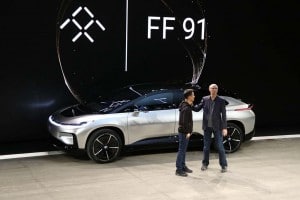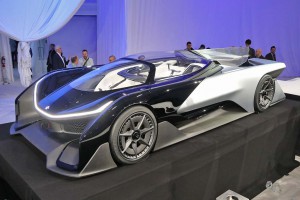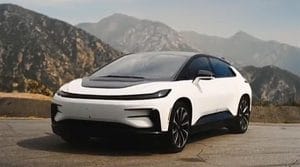
In better days: original backer Jia Yueting and Nick Sampson, helped unveil the FF91 at the 2017 CES.
It’s been a tough couple years for Faraday Future, the battery-car start-up that initially seemed ready to position itself as a serious Tesla challenger, only to have its main source of funding drop out, its planned factory program collapse and a series of other setback befall it.
Somehow, the company has continued to survive, if not thrive, and it claims that a new, if less ambitious, manufacturing center in California will go into production later this year, rolling out the big FF91 battery-electric vehicle. To get across the message that it’s still around, Faraday officials drove an FF91 prototype the 270 miles from Los Angeles to Las Vegas in time for the Consumer Electronics Show, as TheDetroitBureau.com is reporting.
That said, Faraday’s CEO Carsten Breitfeld is well aware of the challenges of trying to turn a profit producing just a single vehicle, and he says the company is laying plans to add at least two additional products. Without them, he told Autoblog at CES 2020 this week, Faraday simply won’t have a future.
“We will have more models,” Breitfeld notes, starting with “the FF81, which is on a smaller wheelbase [than the FF91] and at a much lower price, and the 71 which is even a bit smaller.”
(Faraday officials drive the FF91 from LA to LV with 110 miles of range left.)
While not precisely following the Tesla model, it’s clear that Faraday wants to go down a similar path, starting out with a relatively high-priced flagship and then move more into mainstream. In Tesla’s case, it launched the high-line Model S sedan and Model X SUV before following up with the relatively affordable Model 3. It’s second SUV, the median-priced Model Y is set to come to market later this year.
Faraday originally laid out plans to build a futuristic, 1,000-horsepower supercar, the FF Zero1, which it unveiled at CES 2016. That project appears to have been set aside, if not scrapped entirely. Instead, the company returned to the Consumer Electronics Show a year later with the FF91, a more direct Tesla Model S competitor expected to be priced between $120,000 and $200,000 depending on features and range. That might allow for a reasonable profit margin but it wouldn’t be likely to provide enough volume to support the company without a broader range of higher-volume products.
The project appeared to move quickly. Backed by Jia Yueting, a tech entrepreneur often referred to as China’s Steve Jobs, the company soon lined up, and even broke ground for, a new assembly plant at a sprawling site near Las Vegas.
Then the bottom fell out. Jia’s personal finances collapsed and he had to back out of several automotive projects, including Faraday. A new Chinese investor failed to follow through on funding, leading to a lawsuit and concerns that the company would collapse. A number of senior executives, including co-founder Nick Sampson quit, and, soon afterwards, a large share of Faraday employees were either laid off or hit with major pay cuts.
But a deal to save the company was pulled together, Faraday raising close to $900 million from Birch Lake Fund Management, LP and Chinese videogame company The9 Limited.
(Faraday Future Rescued – Again)

There seems little likelihood the original Faraday Future FF Zero1 supercar ever will make it into production.
Last autumn, Breitfeld confidently declared that the FF91 would be able to go into production in 2020.
Whether that will happen is yet to be proven, and there are plenty of skeptics wondering whether Faraday Future can finally start to deliver on its promises.
Those who have had a chance to experience the FF91 have generally waxed positively about the battery-car, particularly the technology it uses, as well as the roominess of its cabin. The BEV has been designed to take maximum advantage of state-of-the-art electric vehicle design, moving the drivetrain and batteries into a skateboard like platform and reclaiming space normally devoted to the engine compartment for passengers and cargo.
Breitfeld did not disclose any specific details about the smaller FF81 and FF71 models, but even a compact model would likely offer interior space of a class or two larger traditional vehicle.
Such vehicles would likely start moving down into the same range as the Tesla Model 3, perhaps somewhere north of $35,000 for a base FF71.
(Faraday May Have a Future After All)

